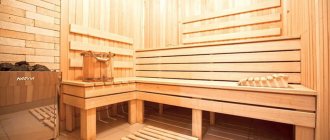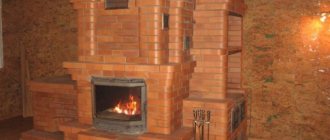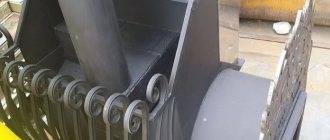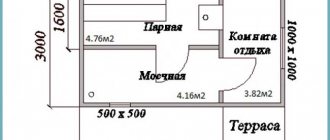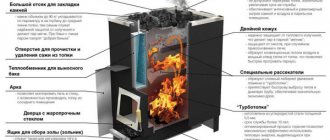After purchasing a stove, some of our clients make a firm decision to install it themselves. We support such initiatives and, whenever possible, help with consultations, because if a person has the time and desire to do something with his own hands, that’s always wonderful. We treat cases with less confidence when clients entrust the installation of a furnace to cheap builders and installers...
The critical difference between these two cases is that the owner will always double-check several times in Yandex: “how to properly install a stove for a bath.” But one-time specialists more often rely on their logic than on SNiP standards - after all, studying the standards is not included in the cost of their work. In this article we will tell you exactly what needs to be checked and taken into account if the installation of the furnace is carried out independently or through dubious specialists.
Why did we decide to write this article? The fact is that about 3 years ago, the government of our country decided that installers of stoves and fireplaces are no longer required to license their activities (Resolution No. 1219 of October 6, 2017).
This means that it’s enough to make a website, fill it with water about your mega-experience, set the price 2-3 times lower than competitors and order advertising. As a result, clients, tempted by the low price, hire such unfortunate masters, after which they find themselves in extremely bad situations. Moreover, the easiest of them is the need to purchase a new stove. But there are worse consequences. You can learn about such “worse” from fire department reports: “The installation was carried out in violation of the standards...”
We recommend not to chase the lowest cost in this matter and either trust professionals, or delve into it and figure it out yourself. It was for the second client case that we decided to prepare a series of articles. This is how this article appeared.
The first piece of advice from our experts is:
If you want to save money on installing a stove for your bathhouse, then understand the basics and supervise the work of hired workers.
If you don’t want to control it, then delve into the issue entirely and install the stove yourself.
If you don’t want to get involved, then leave the issue to a specialized company.
So, you have already built a sauna with a steam room, chosen and bought a stove, and even stocked up on oak brooms. It’s just a matter of little things, well, almost - all that remains is to install the stove and you can enjoy the healing properties of a real Russian wood-fired bathhouse. But to prevent your long-awaited dream from turning into a nightmare, consider the following...
What to install a sauna stove on
A sauna stove, like no other, requires installation on a non-flammable base, because its combustion center is practically on the floor. This means that the temperature load on the floor is greater. We recommend that you use only one of the four base options listed below for sauna stoves.
A metal sheet
Most often, stainless steel or galvanized sheets are used, but painted flood sheets look more beautiful. They come in different sizes, shapes and colors. The options are presented here.
Thermal insulation must be laid under the metal sheet, because... it conducts heat very well. Ordinary basalt cardboard will do, but it is better to additionally use a fiber cement board: faspan, mineralite or flamma.
Agglomerate tiles
This is a tile made from pressed granite chips. Due to the dense structure, the weight of one tile measures 600x600 mm. is 20 kg. As a rule, several pieces are used for the agglomerate base, which are laid on a sheet of CBPB or the same fiber cement board. It is also necessary to use basalt cardboard.
Fig. 1. Base for a sauna stove made of agglomerate tiles
Installation on ordinary porcelain tiles is allowed - the base design will be the same as with agglomerate tiles. But porcelain stoneware is thinner and more fragile, it can burst under the weight of the stove, especially with stones.
Bricks
Installing a sauna stove on bricks is only possible on a flat floor. If a sheet of metal and agglomerate tiles allow for slight unevenness, then the bricks will not “forgive” them - they will move higher and lower. In this case, you will need to level the floor first. If the bricks are laid on a concrete floor, then no thermal protection is required, but if on a wooden floor, then the above-mentioned basalt cardboard can be used.
Fig 2. Grill'D Cometa 180 Vega sauna stove mounted on bricks
Ready bases
Some manufacturers of sauna stoves produce special podiums on which they recommend installing their products. Such podiums, as a rule, do not require additional thermal protection, because have convection channels that cool the floor underneath.
But we consider it not unnecessary to use additional thermal protection under ready-made substrates.
Thermal insulation materials are presented in our section of the website here.
Fig 3. Vesuvius Legend sauna stove installed on the “original” metal base
Bathhouse layout and stove installation features
Before you build a bathhouse, you need to think through in advance all the issues related to the future design. It is worth understanding that proper design makes it possible to create an extremely effective bathhouse that can satisfy all needs.
At the planning stage, it is worth paying special attention to the main functional elements of the bathhouse. In particular, we are talking about a sauna stove, which simultaneously creates heat, provides visitors to the sauna with steam, warms up the entire room and heats the water if a tank was connected to the stove.
Speaking about sauna stoves, we cannot fail to mention the correct choice of a good model. There are a lot of manufacturers involved in the manufacture of bath equipment, whose products can be both quite traditional and suitable for solving a variety of problems. Naturally, such devices differ greatly from each other, and the price range is also wide.
Taking into account all of the above, we can come to the conclusion that a sauna stove needs to be selected individually, depending on operating conditions, the cost of the equipment and personal wishes. Before purchasing a stove, it would be useful to read several articles on how to choose a stove for a sauna.
In any case, when the stove is selected, the next point to which you will have to proceed is the location of the stove in the bathhouse. This will be affected by several groups of requirements that will allow you to install the stove efficiently and reliably, and even extend its service life.
In this sense, two main groups of requirements for the location of the sauna stove can be distinguished:
- Fire safety requirements;
- Requirements for placement depending on the characteristics of the entire building and the premises located in it.
Safe distance from the stove to the flammable wall
A stove is, first of all, a fire, which means there are regulated standards for its installation and operation for fire safety.
The current rules (SNiP dated April 2, 05-91) state the following: The safe distance from the stove to the flammable wall (including wooden shelves) must be at least 500 mm.*
*Appendix 16 (mandatory). Dimensions of grooves and offsets for stoves and smoke ducts.
How to reduce the distance from the stove to the wooden wall and comply with safety standards?
In practice, the distance is 500 mm. You can't always stand it. You will not rebuild the bathhouse. Fortunately, progress is moving forward every day, and modern thermal insulation materials are appearing on the market, which provide much greater protection than those provided for in SNiP itself. Using such materials, the distance can be reduced to 250 mm. We will talk about them below.
How to check the standards in an accessible way?
To make sure that you have maintained a fire-safe distance, test the wall with your hand. If installed correctly, the wall should be warm at the level of the stove.
Of course, the question of the safe distance from the stove to the flammable wall may be a little late if, during the construction of your bathhouse, you did not particularly compare the dimensions of the future stove with the area allocated for it. And if you still made a slight mistake in this matter, now it will be difficult to cram in what you can’t fit in. In any case, we do not recommend compromising your conscience. Call us and we will advise you on what can be done in your specific situation.
Video on how NOT to install a sauna stove
Please note that incorrect installation consists not only of errors in the distance from the furnace to nearby objects, but also of errors in the installation of electrical wiring, its operation, incorrect arrangement of chimney passages through the ceiling, etc. - all this can cause a future fire, but we will talk about this in the following articles.
Simple and affordable shelf options
Experts give many recommendations on the ratio of useful and auxiliary space, the wood used and the method of installing boards or slats. It must be mentioned that between the rear wall of the structure and the wall there must be a space for ventilation of at least 10 cm.
But you can find little advice on choosing the optimal height, and these are mostly practical recommendations that cannot be found in any book:
- the height of a single-tier in a Russian bath should not be higher than the upper edge of the stove (preferably 10 centimeters lower);
- if it is known who acts as a permanent bathhouse attendant, his height is used as a guide, although this advice is questionable, especially for commercial buildings;
- bottom shelf – from 40 to 65 cm;
- medium - so that it is convenient to work with a broom (although if you are short of height, you can stand on the bottom shelf);
- the topmost tier is at least a meter to the ceiling from the head of the person sitting on the top bench.
The dimensions of the canopy - length, width and height - depend not only on the whim of the builder, who, after completing his important mission, will put on a hat, grab a towel and go off to take a steam bath.
This is the most important part after the heating equipment. How useful and comfortable a stay in a bathhouse will be depends on correctly made calculations and standard recommendations based on many years of experience.
Many people really like to relax in a bathhouse, especially if we are talking about their own steam room, built in a country house or countryside. Building your own bathhouse takes some time and requires effort, and this task is associated with a lot of different nuances that arise both at the initial stages of construction and in the future. This article will discuss how to properly position the stove in a bathhouse.
Requirements for the placement of the stove depending on the parameters of the bath
Generally speaking, the location of the stove in the steam room (subject to fire safety rules) is determined arbitrarily, depending on the individual characteristics of the building. However, there are several fairly popular ways of placing a stove - it is not difficult, using proven recommendations, to choose the best option, which will directly depend on the layout of the bathhouse and the number of rooms.
The final layout of the bathhouse is seriously influenced by financial capabilities, depending on which two basic schemes can be distinguished:
- A bathhouse consisting of a steam room and a dressing room. These two rooms are always present in any bathhouse, regardless of its size.
- A bathhouse with additional extensions and premises. In such a scheme, in addition to the steam room and dressing room, any accompanying rooms may be present.
If the budget is tight, the first option is being built - as a rule, such buildings are created for small families, because the size and number of premises in this case are not critical. In addition, with financial constraints and a lack of free space on the site, even such a small building has to be compressed, combining a steam room and a washing area. It will also be useful to know which firewood is best for a bathhouse and how to prepare it.
This approach cannot be called convenient, but its advantages are obvious, which also affects how the stove will be located in the bathhouse. A small bathhouse, consisting of a steam room and a dressing room, allows you to install a stove only in the center of the steam room (naturally, in compliance with fire safety requirements).
The situation will be completely different if financial capabilities do not have any special restrictions. The most important design difference in this case will be the division of the bath into a separate steam room and a washing compartment. This is quite advisable, since the functions of these rooms have serious differences - in the steam room it is necessary to maintain a high temperature, while washing is more comfortable at a gentle temperature regime.
